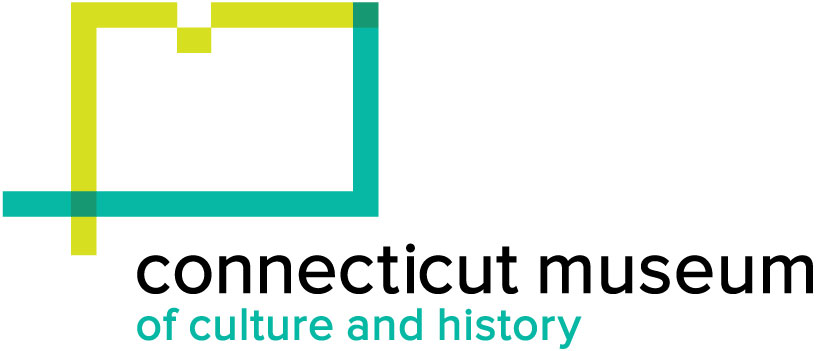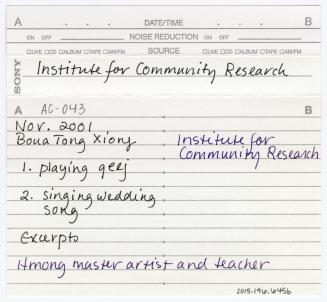Hmong Music
Mediumreformatted digital file from audio cassette
DimensionsDuration (side 1): 30 Minutes, 6 Seconds
Duration (side 2): 30 Minutes, 1 Seconds
Duration (total runtime): 1 Hours, 13 Seconds
ClassificationsInformation Artifacts
Credit LineConnecticut Cultural Heritage Arts Program collections
CopyrightIn Copyright
Object number2015.196.651a-c
DescriptionAudio cassette tape recording of Hmong music.
NotesSubject Note: The cassette tape was given to Lynne Williamson in July 2000 by Vang Xiong.Subject Note: The Hmong community in Connecticut, around 300 in number, is based mostly in the Enfield and Manchester areas. They work in factories and service occupations, as well as skilled manufacturing, often in aerospace industries. The Hmong came to the United States as refugees from the Indochina wars in the 1970s after the Communist takeover of Laos, sponsored by the American government because many Hmong assisted the military and the CIA. At that time the Hmong were persecuted in Laos, and this still continues today with considerable fighting going on. The Hmong are a tribal group originally from Mongolia who migrated to Laos where many still live today. There are also Hmong communities in northern Burma, Vietnam, Thailand, and China (where they are called Miao).
Connecticut Hmong people are both traditional and contemporary. Older women used to make the gorgeous applique and embroidery work known as paj ndau, and they still create traditional costumes for women and men, albeit with modern shortcuts (traditional dyeing techniques are replaced by printed cloth, for instance). Men who are traditional community leaders, such as Boua Tong Xiong, still perform wedding and funeral rituals, as well as conflict resolution according to time-honored practices. Hmong traditions practiced in Connecticut include embroidery and story cloths, funeral and wedding songs, music on the bamboo instrument qeej, ballads and courtship songs kwv ntxhiaj, and social dancing. Hmong leaders started the Hmong Foundation of Connecticut as a way to keep the community together and continue to provide many kinds of needed assistance. The Foundation, which is led by a Board of Directors, is open to all Hmong living in the state. Members provide services such as translation, transportation, family relocation to Connecticut, assistance with finding jobs and access to health care, Hmong language classes, and traditional Hmong advising and dispute resolution. The Hmong Foundation of Connecticut became a separate organization in 1996 after the Connecticut Federation of Refugee Assistance Agencies, an umbrella service group, disbanded. The group sponsors Hmong New Year in November and a celebration for Hmong high school graduates in June.
The Hmong have a number of sub-cultural groups; one of the distinguishing characteristics of the Blue Hmong is their custom of batiking cloth with blue indigo. One specific kind of textile that the Hmong have become known for are the “story cloths”. These are a comparatively new genre first made in the Thai refugee camps around 1975. In these embroidered pieces, direct figurative references are made to folk tales, myths, personal family stories, and scenes of village life. These story cloths also depict the turbulence and hardships of the war years in Southeast Asia. Hmong textile works also include many references to the natural world, to the plants and animals, which are native to the hills of Laos. (Winifred Lambrecht, Ph.D (CCHAP project partner); July 2006)
Hmong New Year - Nyob Zoo Xyoo Tshiab - is the Hmong community’s most important annual festival. The New Year festival, always held late in the year, includes the ball toss, a game between young people that is a courtship ritual; a fashion show of different tribal costumes; a cultural presentation of dance and song; and a community-prepared feast with traditional foods. The spiritual connotation of the festival is for thanksgiving and new beginnings, and to honor ancestors. Hmong participants wear traditional dress, make speeches, and sing songs appropriate to the celebration. New Year also serves as a reminder and practice of traditions, as well as a gathering of cultural and social leaders.
Additional materials exist in the CCHAP archive for this community.
Cataloging Note: This project was made possible in part by the Institute of Museum and Library Services MA-245929-OMS-20.
Status
Not on viewRamón Arroyo
2002 August 7; ca. 1997











